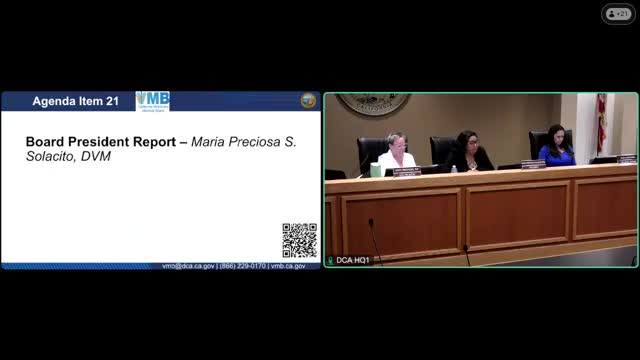Stakeholders say some compounded veterinary drugs are unavailable in California after Board of Pharmacy rule changes
October 22, 2025 | Respiratory Care Board of California, Boards and Commissions, Executive, California
This article was created by AI summarizing key points discussed. AI makes mistakes, so for full details and context, please refer to the video of the full meeting. Please report any errors so we can fix them. Report an error »

Stakeholders told the California Veterinary Medical Board on Oct. 22 that a recent Board of Pharmacy rulemaking and enforcement interpretation has made a small number of compounded veterinary drugs unavailable in California, and participants described ongoing talks to find interim and longer-term fixes.
Why it matters: veterinarians said the affected products include drugs used for equine ophthalmic care. For veterinarians treating horses and some exotic species, the absence of these compounded preparations could constrain clinical options.
What stakeholders reported
At a joint stakeholder meeting convened Oct. 1 by the Veterinary Medical Board and the Board of Pharmacy, attendees identified multiple potential causes for limited availability of compounded products in California: a federal FDA guidance (GFI) and the U.S. Pharmacopeia (USP) compounding standards, the Board of Pharmacy's recent regulatory package and local interpretations of those federal guidance documents, and practical business decisions by large compounding pharmacies about demand and shipping logistics.
Grant Miller, representing the California Veterinary Medical Association, said: "At this moment, there are still medications in California that are not available here," and he named about "7 medications that are mainly equine ophthalmics" including voriconazole, chloramphenicol and diclofenac as drugs of concern. Miller said some compounding vendors interpret the Board of Pharmacy's enforcement of gamma-irradiation guidance to require gamma facilities to be co-located with compounders, which has led to some vendors not shipping certain products into California.
Vendor perspectives and technical barriers
Representatives from major compounding firms told the stakeholder meeting that different vendors had different reasons for limiting distribution into California. One vendor cited the Board of Pharmacy's enforcement interpretation and the logistics of gamma sterilization; another said limited commercial demand for specific concentrations or presentations made production and shipping uneconomic. Stakeholders discussed federal pathways for adding drugs to FDA lists that clarify availability and noted that some drugs can be shipped while an FDA review is pending.
Board response and next steps
Board staff said they will continue to facilitate discussions among the Board of Pharmacy, compounding pharmacies and veterinary stakeholders. Staff and CVMA representatives expressed interest in compiling a prioritized list of medications and working to identify short-term fixes (such as interim shipping agreements or alternate suppliers) and longer-term regulatory or statutory remedies if needed. "I hope that this is not the last of the dialogue with the board of pharmacy," CVMA's Grant Miller said.
Ending: board members and staff said they will continue outreach and information-sharing with the Board of Pharmacy and compounding vendors and may return to the board with recommendations or requests for assistance if interim solutions are not found.
Why it matters: veterinarians said the affected products include drugs used for equine ophthalmic care. For veterinarians treating horses and some exotic species, the absence of these compounded preparations could constrain clinical options.
What stakeholders reported
At a joint stakeholder meeting convened Oct. 1 by the Veterinary Medical Board and the Board of Pharmacy, attendees identified multiple potential causes for limited availability of compounded products in California: a federal FDA guidance (GFI) and the U.S. Pharmacopeia (USP) compounding standards, the Board of Pharmacy's recent regulatory package and local interpretations of those federal guidance documents, and practical business decisions by large compounding pharmacies about demand and shipping logistics.
Grant Miller, representing the California Veterinary Medical Association, said: "At this moment, there are still medications in California that are not available here," and he named about "7 medications that are mainly equine ophthalmics" including voriconazole, chloramphenicol and diclofenac as drugs of concern. Miller said some compounding vendors interpret the Board of Pharmacy's enforcement of gamma-irradiation guidance to require gamma facilities to be co-located with compounders, which has led to some vendors not shipping certain products into California.
Vendor perspectives and technical barriers
Representatives from major compounding firms told the stakeholder meeting that different vendors had different reasons for limiting distribution into California. One vendor cited the Board of Pharmacy's enforcement interpretation and the logistics of gamma sterilization; another said limited commercial demand for specific concentrations or presentations made production and shipping uneconomic. Stakeholders discussed federal pathways for adding drugs to FDA lists that clarify availability and noted that some drugs can be shipped while an FDA review is pending.
Board response and next steps
Board staff said they will continue to facilitate discussions among the Board of Pharmacy, compounding pharmacies and veterinary stakeholders. Staff and CVMA representatives expressed interest in compiling a prioritized list of medications and working to identify short-term fixes (such as interim shipping agreements or alternate suppliers) and longer-term regulatory or statutory remedies if needed. "I hope that this is not the last of the dialogue with the board of pharmacy," CVMA's Grant Miller said.
Ending: board members and staff said they will continue outreach and information-sharing with the Board of Pharmacy and compounding vendors and may return to the board with recommendations or requests for assistance if interim solutions are not found.
View full meeting
This article is based on a recent meeting—watch the full video and explore the complete transcript for deeper insights into the discussion.
View full meeting
